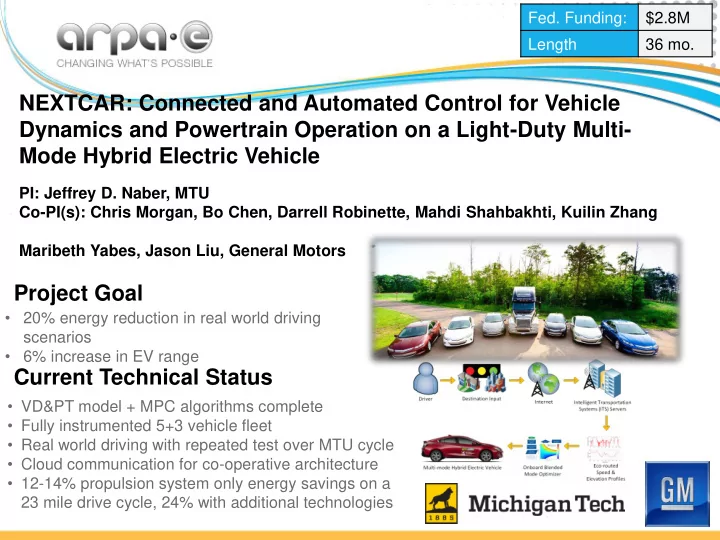

Fed. Funding: $2.8M Length 36 mo. NEXTCAR: Connected and Automated Control for Vehicle Dynamics and Powertrain Operation on a Light-Duty Multi- Mode Hybrid Electric Vehicle PI: Jeffrey D. Naber, MTU Co-PI(s): Chris Morgan, Bo Chen, Darrell Robinette, Mahdi Shahbakhti, Kuilin Zhang Maribeth Yabes, Jason Liu, General Motors Project Goal • 20% energy reduction in real world driving scenarios • 6% increase in EV range Current Technical Status • VD&PT model + MPC algorithms complete • Fully instrumented 5+3 vehicle fleet • Real world driving with repeated test over MTU cycle • Cloud communication for co-operative architecture • 12-14% propulsion system only energy savings on a 23 mile drive cycle, 24% with additional technologies
Technical Accomplishments • 3 control and 5 instrumented vehicles with LiDAR, GPS Sensing, DSRC, on board telemetry CACC, and OEM Control system interface • 100% of traffic lights on MTU Drive Cycle equipped with MDOT RSU’s
Technical Accomplishments • Developed 11 propulsion system and CAV energy efficiency improvements. • 13 different real world drive cycles for analysis of Urban/Highway, congestion, eco- routing, driver variance, etc. 21.4 • Full MPC capability with cloud based V2X 14.7 42% Savings Commerce, MI
Updated Efficiency Breakdown Table By Specific Maneuver: Validation/Testing/Demonstration Plan Individual Energy Technology Area Description Task # Reduction Analytical/Simulation Experimental In Vehicle Algorithm: 4-7% (95% CI) 2-9% 5% Propulsion System 1 Drive Unit Mode Optimization 3 Requires GM 1-9% 1-9% upwards of 12% (95% CI) 2 PHEV Blended Mode 4 2-5% 1-7% (95% CI) In Progress - Target Q10 3 Velocity Profile Optimal velocity planning 3 2-14% 7% 1-6% (CI 95%) 4 CACC Cooperative drive profiling 2 & 4 Eco optimized stopping and Target Q10 2-10% 2-8.6% (CI TBD) 5 EcoAND going 2 & 4 0-31% (92% CI) 2-12% 2-42% (CI TBD) 6 EcoRouting Energy based route selection 2 &4 2-9% 2-13% 1-7% (CI TBD) 7 Spd HARM Coordinating platoon speeds 2 & 4 Additional Technologies In Development Requires GM (Some Experimental Confirmations are Propulsion Thermal PT Thermal Modeling & Target Q9 TBD Possible) 8 Management Control 1 Requires GM (Some Experimental Confirmations are Cabin HVAC Modeling & 0-28% (CI 92%) 3-5% Possible) 9 Intelligent HVAC Control 1 Total Combined Measured Reduction Target Q11 Target Q11 PHEV savings along entire 23 mile MTU Drive Cycle: PT Tools HVAC Improvement Eco A&D Speed Harm Eco Routing +2%* 21% *Assumes likelihood of EcoRoute Option
Tech-to-Market Strategy • Approach to market • 6 Technology disclosures have been made to General Motors as commercialization partner who has preferential rights to technology under a mutually executed Participation Agreement. • Review procedures for General Motors in place as they consider technology disclosures for proprietary protection and commercial adoption. • Several other OEM, Tier 1 suppliers interested T2M/TTO event in May at ACM to highlight • Anticipated first markets • General Motors vehicles, application, research and development, and strategic partners/joint ventures. • Approach to manufacture • General Motors, General Motors’ suppliers, strategic partners.
Tech-to-Market Strategy • Outreach activity to strategic automotive industry professionals scheduled at the American Center for Mobility • This Activity intended to serve as a follow up from general public awareness outreach demonstrated in Texas during Spring 2018
Key Lessons Learned Improvement in propulsion system modelling routine through combined dynamic and reduced order techniques Driver aid technology difficult to implement prior to more autonomous vehicle capability established. Real time accuracy of map and grade information critical for application of CAV technologies Energy savings potential for PHEV’s in Propulsion and Cabin Thermal Management Model predictive propulsion system control has energy benefits, but correctly implemented also drivability and performance benefits as well. A true “apples to apples” approach is required when realizing efficiency improvements in a light duty vehicle application, and should be considered for an entire drive cycle, not a single driving maneuver.
Current Challenges Real-time, coupled traffic simulation via cloud to the CAV fleet Developing methodology for “fair reporting” and integration of short term technology applications and eco-routing into real-world energy benefits Effective and efficient methods for determining impact of lane position, CAV penetration rate, and congestion into simulation results Limited opportunities for testing due to weather (304” / 25 feet of snow )
Recommend
More recommend